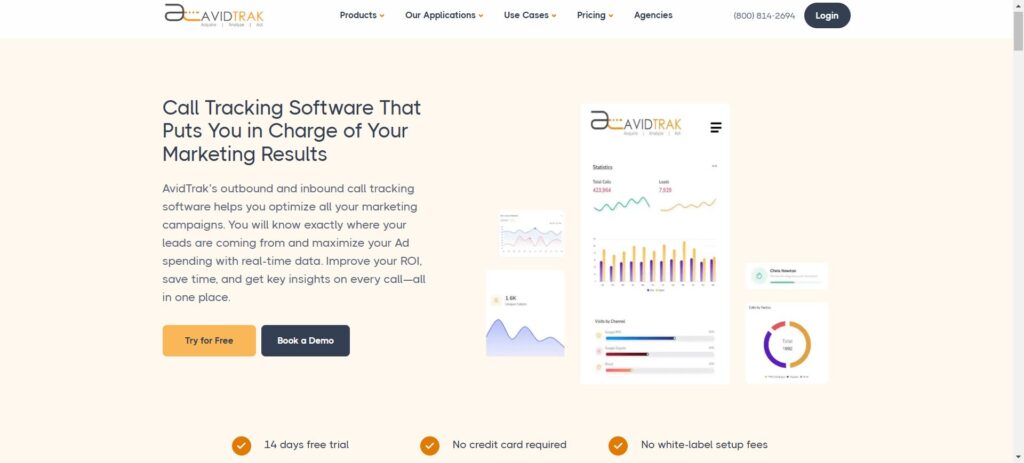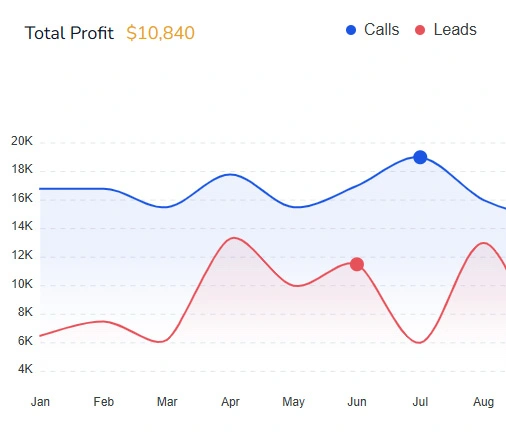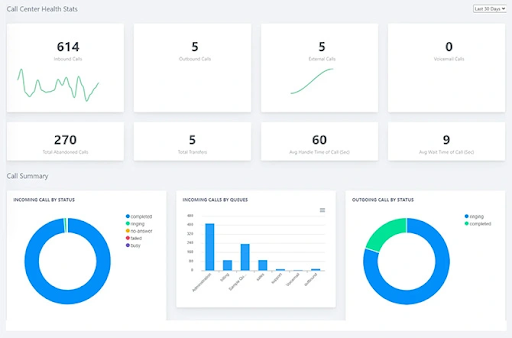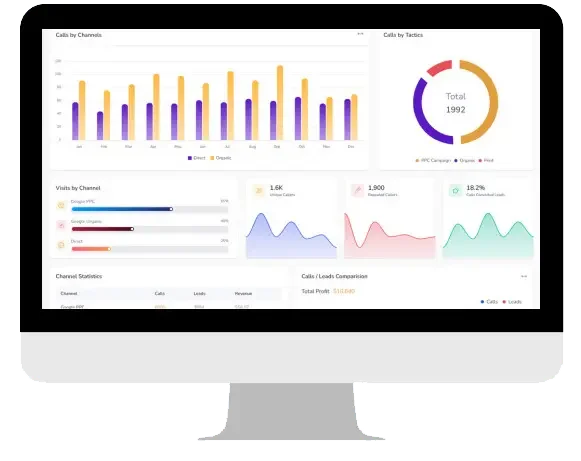Ever wondered how call tracking and lead maximization work together for higher sales? You might have the best marketing strategy, running paid ads, optimizing for SEO, and even driving organic traffic, but if you don’t know where your leads are coming from or how to follow up with them effectively, you’re losing out on sales opportunities.
That’s exactly where call tracking and lead maximization come in. Call tracking tells you which marketing efforts are driving inbound calls, helping you focus on what’s working.
Lead maximization guarantees that no lead gets lost, assigns priority, sends timely follow-ups, and improves conversion rates by keeping engagement strong.
Understanding how these two strategies work together is key to building a stronger, more efficient sales funnel.
Let’s break down how call tracking improves lead management and how lead maximization turns inquiries into conversions.
Summary
- Call tracking provides real-time insights into inbound calls, helping businesses track lead sources, measure marketing effectiveness, and optimize ad spend.
- Lead maximization ensures no lead is lost by analyzing engagement patterns, call data, and inquiry context to assign priority scores. AI-driven workflows automate follow-ups via CRM integrations, keeping engagement high and increasing sales conversions.
- Combining call tracking and lead maximization creates a structured sales funnel, ensuring fast lead response, real-time segmentation, and higher engagement.
- Sales teams benefit from integrated tools that streamline workflows, improve collaboration, and make sure leads are handled efficiently at every stage.
- Businesses maximize ROI by refining marketing strategies with data-driven insights, optimizing ad targeting, and reallocating budgets to top-performing campaigns.
- AvidTrak software is recommended for call tracking and lead maximization integration, as it provides an elegant solution that combines the two functions in a single platform. AvidTrak is the most cost-effective platform in the industry and seamlessly tracks calls and also manages leads, yielding higher ROI and optimized sales performance.
The Role of Call Tracking in Optimizing Lead Management
Call tracking is an essential tool for businesses that rely on phone conversations to drive sales. It provides real-time insights into customer interactions, helping businesses analyze the source of inbound calls and measure the success of their marketing campaigns.
Real-Time Call Insights
Want to know exactly which marketing efforts are bringing in calls? Call tracking provides a real-time view of attribution, whether a lead was a dial-in from a Google Ad, a social media post, or a TV commercial. By combining first-touch and multi-touch attribution models, businesses can measure campaign effectiveness with precision.
Let’s say a campaign offering a “free consultation” is driving the most calls—why stop there? Double down on that message, fine-tune your ads, and watch engagement grow. When you have real-time insights, every marketing dollar goes further.
Lead Qualification and Prioritization
Not every call is worth pursuing, and sales teams need to focus on leads that show real buying intent.
Call tracking helps categorize calls based on:
- Call duration – longer calls often indicate higher interest.
- Keywords mentioned during the conversation – for example, “pricing,” “appointment,” “service plans”
- Repeat callers vs. first-time inquiries.
By filtering out unqualified leads, businesses can streamline their sales funnel and prioritize hot prospects.
Attribution Across Multiple Channels
Marketing isn’t just about one channel—customers can come from Google Ads, Facebook campaigns, email marketing, print ads, or even a billboard they saw on their commute. Without the right tracking in place, it’s impossible to know which marketing tactics are actually driving results.
Instead of guessing where to invest, companies can allocate budgets based on cost per lead (CPL), customer acquisition cost (CAC), and lifetime value (LTV)—ensuring marketing spending is allocated to the highest-performing channels.
Whether it’s tracking PPC ads or measuring the impact of offline marketing, data-backed decisions lead to better ROI.
How Lead Maximization Enhances Sales Conversion
Getting a lead is just the first step—what happens next determines whether they convert or disappear.
A slow response (over 5 minutes), missed follow-up, or generic outreach can cause potential customers to disengage, reducing conversion chances by over 50%. Lead maximization ensures that no opportunity is wasted by prioritizing high-value leads, automating follow-ups, and keeping engagement strong.
With the right strategy, businesses can shorten sales cycles, improve response times, and turn more inquiries into actual sales.
Lead Scoring and Prioritization
Not every lead is ready to buy, and treating them all the same can waste time and slow down conversions.
AI-driven lead scoring helps businesses identify high-value prospects by analyzing call intent, engagement level, and past interactions.
With the right system, sales teams can focus on hot leads while nurturing those who need more time.
- A lead asking about booking a demo? High-priority—needs immediate follow-up.
- A casual inquiry about business hours? Lower priority—can be handled through automated responses.
- A repeat caller exploring multiple service options? Best suited for a senior sales rep who can close the deal.
With real-time call insights and smart segmentation, businesses can streamline their sales process, reduce response times, and increase conversion rates—without wasting resources on leads that aren’t ready to convert.
Personalized Follow-Ups
With real-time call tracking, businesses can automate follow-ups with personalized emails and SMS messages that match a lead’s interests. Instead of generic responses, potential customers receive timely, relevant information, keeping engagement strong and moving them closer to a sale.
- A lead asking about pricing? They can instantly receive an email prompting a follow-up call with a sales rep or a dynamic pricing guide based on their needs.
- Is a prospect interested in features? An automated SMS with key benefits and a case study can reinforce their decision.
By integrating call tracking with lead management, companies respond faster, personalize interactions, and increase conversions without extra manual effort.
Nurturing Leads Until They’re Ready to Convert
Some leads need multiple touchpoints before they convert. Without structured follow-ups, potential customers can slip away.
Call tracking combined with CRM and automation tools keeps engagement strong by triggering personalized emails, SMS reminders, and retargeting ads based on call insights.
- Follow-up emails & reminders – Automatically send personalized emails based on call intent, keeping leads informed and interested.
- SMS updates on offers & promotions – A quick text message with a limited-time discount or a special promotion can push leads toward conversion.
- Retargeting ads based on call insights – If a lead calls but doesn’t convert, AI-driven call tracking can trigger targeted ads to re-engage them at the right time.
With smart automation, businesses can reduce lead loss and close more deals effortlessly.
Combining Call Tracking and Lead Maximization for a Seamless Sales Funnel
When a lead calls, every second matters. A slow response or missed follow-up can mean lost revenue.
With the right tools, businesses can:
- Track and attribute calls from PPC ads, social media, and offline campaigns.
- Route calls intelligently based on location, time of day, or IVR selections.
- Prioritize hot leads with AI-driven analytics to improve response times.
Here’s how these tools work together to create a stronger sales funnel.
From First Contact to Closing the Deal
Every successful sale starts with an initial inquiry—but how businesses respond and follow up determines whether they win or lose the deal.
A structured process ensures no opportunity is missed, helping companies turn inquiries into revenue.
Here’s how a smooth sales funnel works:
- A lead calls in after seeing a PPC ad, social media post, or offline campaign.
- Call tracking records key details such as marketing source, caller intent, and engagement level.
- Lead maximization prioritizes high-intent leads for faster follow-ups.
- Automated follow-ups via email or SMS reminders keep engagement strong.
With real-time insights and automation, businesses can respond faster, close more deals, and stop leads from slipping away.
Real-Time Lead Segmentation
Not every lead is the same; some are ready to buy, while others need more nurturing. Effective segmentation helps agencies focus on the right prospects, improving response times and conversions.
- Identify high-value leads – Fast-track prospects showing strong buying signals.
- Customize responses based on call insights – Use real-time tracking to customize follow-ups.
- Connect leads to the right team member – Route calls strategically to boost engagement.
- Pricing inquiries? AI-based routing ensures immediate connection with a rep.
- Feature comparisons? Automated emails with case studies help nurture leads through the funnel.
- Demo requests? Instantly schedule a walkthrough with a sales expert.
This segmentation manages every lead so that it is catered to based on their behavior and stage in the buying journey, leading to higher conversion rates.
Lead Nurturing & Conversion Automation
Manually following up with leads takes time and leaves room for mistakes. Automated workflows eliminate delays, keeping prospects engaged and increasing the chances of conversion.
Here’s how a structured lead nurturing system works:
- Call Data Capture – Every call is logged with details like marketing source, caller intent, and engagement level so that no lead is overlooked.
- Automated Follow-Ups – If a lead shows interest in pricing, an email can be triggered with pricing details, case studies, or an exclusive offer.
- Email Nurturing – Leads that don’t convert immediately receive personalized follow-ups, reminders, or retargeting ads, keeping them engaged until they’re ready to buy.
Streamlining Sales Team Workflow with Integrated Tools
A great sales team isn’t just about skilled representatives—it’s about having the right systems in place to keep things running smoothly. Without a structured approach, leads can slip away, follow-ups can be delayed, and valuable prospects might end up lost in the shuffle while time is spent on low-priority inquiries.
With call tracking and lead management tools, businesses can create a more connected workflow where sales, marketing, and customer service teams all have access to the same customer insights.
When teams can see where a lead came from, what they’re interested in, and how they’ve engaged so far, it becomes easier to respond quickly, prioritize the right prospects, and ensure no opportunity is wasted.
Here’s how these tools make a difference in sales team collaboration, training, and lead distribution.
Improved Collaboration
Sales, marketing, and customer service teams work best when they have access to the same customer insights. When call tracking and lead management tools are synced with CRMs, every department stays aligned.
- Marketing teams can track which campaigns bring in the most qualified leads.
- Sales teams can analyze past interactions to personalize follow-ups.
- Customer support teams can access call recordings and transcriptions to provide better service.
When everyone works with real-time data, leads don’t get lost, and customers receive a seamless experience at every stage.
Coaching and Training Sales Teams
Success in sales doesn’t just mean how many deals you close; it’s about learning what works.
With call recording and AI-driven analytics, managers can gain insights into call performance and refine sales strategies.
By reviewing real conversations, sales leaders can:
- Identify common objections and develop stronger responses.
- Train reps using real examples of successful calls.
- Spot areas for improvement, such as response time and engagement tactics.
When sales teams continuously learn from their interactions, they become more effective in handling leads and closing deals faster.
Lead Handoff and Distribution
One of the biggest challenges in sales is handing off leads from marketing to sales without delays. Automated call tracking and lead routing can eliminate this gap by assigning leads to the right team member based on location, engagement level, and inquiry type.
For instance:
- Local service inquiries can be routed based on zip code tracking combined with intent signals, ensuring leads are connected to the right team at the right time.
- High-intent leads can be prioritized for immediate sales follow-up.
- Lower-priority inquiries can be placed in a nurturing campaign until they’re ready to convert.
This reduces response delays and manual handoffs, making the entire process more efficient and effective.
Optimizing Follow-Up Timing and Frequency
The timing of a follow-up can be the difference between a conversion and a lost lead. Contacting too soon might feel intrusive while waiting too long can cause a prospect to lose interest.
Analyzing engagement trends and past call data helps businesses time their outreach more effectively.
By using AI-powered call tracking and caller intent analysis, businesses can determine the best time to reconnect with leads.
- If most calls occur between 10 AM and 2 PM, sales teams can prioritize follow-ups during these hours for higher engagement.
- Leads requesting a demo can receive a follow-up email within an hour to maintain interest.
- High-intent prospects asking about pricing can be scheduled for a call within 24 hours to move them closer to a sale.
Identifying the Best Time to Follow-Up
Not all leads engage at the same time. Some require an immediate callback, while others need strategic nurturing before making a decision. Tracking call patterns and customer behavior helps businesses refine their outreach strategy.
Call tracking data reveals when leads are most likely to respond.
If most inbound calls occur mid-morning, then follow-ups during that window can increase response rates. Zip code-based call forwarding can also help direct inquiries to the nearest sales rep, reducing wait times and improving conversions.
Determining the Right Frequency for Follow-Ups
Finding the right follow-up frequency can make or break a sales cycle. Too many follow-ups can overwhelm a lead, while too few can result in lost sales opportunities.
Let’s see how you can differentiate between leads,
- A lead requesting a product demo might need a follow-up email within an hour.
- A potential high-quality lead interested in pricing can be scheduled for a call within 24 hours.
- Leads that don’t engage after an initial call can be placed in an automated email campaign, keeping them engaged over time without overwhelming them.
With AI-driven speech analytics, CRM integrations, and real-time caller intent tracking, professionals create structured outreach strategies that align with customer behavior, boosting conversion rates.
Improving Marketing ROI with Call Tracking and Lead Maximization
Marketing budgets should be focused on campaigns that drive real sales, but without clear attribution, businesses often invest in ineffective channels.
Call tracking and lead management tools provide data-driven insights that help optimize marketing efforts, and increase return on investment (ROI).
Effective Budget Allocation
Not all marketing efforts generate the same level of engagement. Blindly spending on ads, SEO, or social media without tracking inbound calls can lead to wasted resources.
Using dynamic number insertion (DNI), businesses can track which PPC ads, landing pages, and offline campaigns generate high-value leads.
This allows them to:
- Invest more in top-performing marketing efforts.
- Adjust strategies for underperforming campaigns.
- Optimize keywords based on real-time call data.
With precise campaign tracking, businesses can make informed marketing decisions that directly impact revenue.
Data-Driven Campaign Refinement
Refining a marketing strategy requires more than just looking at conversion rates—it involves understanding customer behavior and adjusting messaging accordingly.
- Optimizing Ad Messaging
If call tracking shows that many leads inquire about pricing, businesses can highlight cost details in ads and landing pages to attract more qualified prospects.
- Adjusting Targeting
If a certain region or customer segment responds better, budgets can be shifted to focus on that audience.
How AvidTrak Helps Integrate Call Tracking and Lead Maximization for Higher Sales
Businesses need more than just basic call tracking—they need a cost-effective, expert-backed, and fully supported solution that not only captures inbound calls but also turns them into revenue-generating opportunities.
AvidTrak’s advanced call tracking and routing direct leads to the right team instantly, while CRM integrations keep sales and marketing teams aligned. With AI-driven analytics, businesses can track, manage, and prioritize leads more efficiently, resulting in faster follow-ups, better customer engagement, and higher conversion rates.
Here is how AvidTrak’s key features optimize lead tracking, follow-ups, and sales conversions for a more efficient sales funnel.
Unified Platform

AvidTrak combines call tracking and lead maximization into a single, integrated platform that automates lead logging, categorization, and routing, eliminating missed opportunities. With DNI, businesses track calls from Google Ads, SEO, and social media, while AI-driven leads scoring prioritizes high-intent prospects.
IVR call routing connects callers to the right team, and call recording & transcription provide insights to refine sales strategies—helping businesses maximize leads for stronger sales.
Real-Time Data and Insights

AvidTrak’s real-time call tracking uses NLP-based intent recognition, call recordings, and lead scoring models to provide sales teams with instant visibility into customer needs—eliminating guesswork and improving response accuracy. It tracks leads across multiple channels—PPC ads, SEO, social media, print, and even billboards—while analytics reveal patterns to refine marketing strategies.
With CRM integrations for Salesforce, HubSpot, and Zoho, lead records update automatically, keeping sales workflows efficient and response times fast—driving higher conversions with less effort.
Customizable Lead Management

AvidTrak’s lead management system allows businesses to customize workflows, automate lead assignments, and tailor follow-up sequences for maximum efficiency. With automated lead scoring, prospects are ranked based on call intent analysis, keyword detection, call duration, and engagement history, ensuring high-priority leads receive immediate attention.
SMS and email automation nurture leads with personalized follow-ups, while AI-driven call routing ensures prospects are connected to the most relevant sales representative based on location, intent, and engagement level.
Every inquiry is tracked, assigned, and nurtured without manual effort, leading to faster response times and higher conversions.
Comprehensive Reporting

AvidTrak’s advanced reporting tools provide businesses with in-depth analytics on call attribution, lead conversion trends, and sales performance, helping optimize strategies and maximize ROI.
Multi-touch call attribution helps businesses identify the most effective marketing efforts, while conversion tracking measures lead progression from first inquiry to final sale, providing full-funnel visibility.
Sales performance analytics track key metrics like first response time, lead follow-up frequency, and close rates, helping teams improve efficiency and optimize sales workflows. Businesses can cut wasted ad spend and boost revenue with data-backed decisions through custom dashboards, automated reports, and real-time insights.
With AI-driven trend analysis and proactive alerts, teams can adjust strategies instantly for better outcomes.


